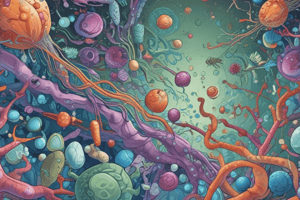Podcast
Questions and Answers
What is the primary mechanism of action of urinary antiseptics in the treatment of UTIs?
What is the primary mechanism of action of urinary antiseptics in the treatment of UTIs?
- Reducing the pH of urine
- Boosting the immune system
- Systemic antibacterial effects
- Inhibiting bacterial growth in urine (correct)
What is the common practice when administering urinary antiseptics?
What is the common practice when administering urinary antiseptics?
- Administering with antibiotics to enhance effects
- Administering with probiotics to promote gut health
- Administering with alkalizing agents to increase pH
- Administering with acidifying agents to lower pH (correct)
Which of the following bacteria is not susceptible to nitrofurantoin?
Which of the following bacteria is not susceptible to nitrofurantoin?
- E. coli
- Staphylococcus saprophyticus
- Proteus (correct)
- Pseudomonas aeruginosa
What is the primary characteristic of urinary antiseptics?
What is the primary characteristic of urinary antiseptics?
Why do urinary antiseptics lack systemic antibacterial effects?
Why do urinary antiseptics lack systemic antibacterial effects?
What is the primary mechanism by which nalidixic acid acts against gram-negative organisms?
What is the primary mechanism by which nalidixic acid acts against gram-negative organisms?
Which of the following drugs is NOT active against Proteus?
Which of the following drugs is NOT active against Proteus?
What is the consequence of combining methenamine with sulfonamides?
What is the consequence of combining methenamine with sulfonamides?
What is the primary route of excretion of nalidixic acid?
What is the primary route of excretion of nalidixic acid?
What is a common adverse effect of nitrofurantoin?
What is a common adverse effect of nitrofurantoin?
Flashcards are hidden until you start studying




